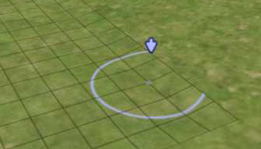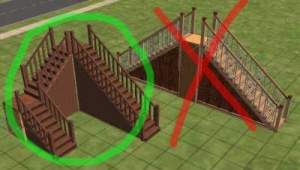Contents |
Introduction
This is a "tiptorial" designed to help anyone who is struggling to build a better house. Rather than covering specific techniques, it is more a general style guide, meant to teach you what a good house (and one that sucks) look like, and how to improve your own building. It is geared toward creating "normal family homes" - which form the bulk of what people tend to download. It doesn't address building things like spaceships, though some of the tips here are useful for all lots!
This guide does not require any prior knowledge or skill in building besides being familiar with the build tools, but knowing a few terms will be useful. This article can also be helpful for expert builders - if you want some tips on improving your building skills, you've come to the right place! After reading this tutorial, you should be able to make better houses, no matter how advanced you are currently.
This tiptorial covers all of the main aspects of building, from foundations to landscaping to to decorating. You can skip to particular sections using the Table of Contents listing above. You can read the entire tutorial, or just a few bits, to learn skills that you can use every time you build a house.
Before You Begin
Before you even open the game, here's some very important information you should be aware of!
- TS2 Only: ALWAYS BUILD ON A PERFECTLY FLAT LOT. Not a lot that you "flatten to street level" or drag the level tool all the way across. The entire lot border around the outside edge of the tiles needs to be flat and level with no slope to it. See the tiles on the very edge in the picture ot the right? They aren't flat.
The reason for building on a flat lot is so the lot will sit nicely next to its neighbors, and won't reshape the neighborhood terrain. Once an unlevelled lot is placed, the way it reshapes the neighborhood terrain can be permanent. Your sloped hood can mess up all the careful neighborhood sculpting someone has done, and it can be impossible to fix it, ever.
The one exception to this rule is if you intend to build a beach lot (they aren't flat) or if you wanted to build a house on a hill or into a hill. Be conscious of what you are doing and make sure to mention when you upload your lot that it's not level, so people who download it aren't surprised!
- TS2 Only: If you've never used Numenor's AnyGameStarter, you NEED to try it! Normally, any lot you build will require all the Expansion Packs that you have installed - regardless of whether you've used stuff for them or not! Stuff packs are normally only required if you used the items from them. But using the AnyGameStarter, you can run your game with only the expansions you need to build the lot you want to make. Remember this when you are uploading and mention in your post that you used the AGS.
Planning Your Lot
You've decided you want to build, but where do you start?
Whether you choose to reproduce a real house or make up one out of your own imagination, it's usually best to plan carefully before you even choose a blank lot to start.
![]() Tip: You don't need to use the biggest lots in the game for family homes! Those are not really made for houses. Those are for community lots for people with super computers. To build a nice house you should pick a 2x2, 2x3, or 3x3, or even MAYBE a 3x4. Anything else is far bigger than you need to make a "normal family home," which is what this guide covers creating.
Tip: You don't need to use the biggest lots in the game for family homes! Those are not really made for houses. Those are for community lots for people with super computers. To build a nice house you should pick a 2x2, 2x3, or 3x3, or even MAYBE a 3x4. Anything else is far bigger than you need to make a "normal family home," which is what this guide covers creating.
![]() Tip: Graph paper is very useful for planning purposes, since it's got a nice little grid, and you can line things up and see how they fit together before you ever lay down the first section of wall. It also gives you a good idea of how big your whole lot should be - you can count the number of squares your actual house uses and decide what lot size you need without realizing you've run out of room, or have a big block of land you don't know what to do with.
Tip: Graph paper is very useful for planning purposes, since it's got a nice little grid, and you can line things up and see how they fit together before you ever lay down the first section of wall. It also gives you a good idea of how big your whole lot should be - you can count the number of squares your actual house uses and decide what lot size you need without realizing you've run out of room, or have a big block of land you don't know what to do with.
Real Life Inspiration
One of the best ways to learn how to build realistic houses is to take your inspiration from real life homes and styles. Usually, you should build for overall scale, playability, window/door placement, and symmetry. Real homes aren't limited to square tiles to place walls, windows, doors, stairs, etc., so you will have to adjust the real home to fit the game. For example, you can't center a single tile door between two tiles, so you will need to decide whether to make that section of wall one tile, or three, or to put the door off-center.
Real Life Scale in Tiles: As a general rule, 1 square tile is approximately equal to 1 meter or 1 yard (3 feet). You will usually have to round up or down (and adjust for the factors mentioned in this section) rather than building to the exact size of the real-life home.
Floor Plans
Many people enjoy building from real life floor plans. You can find tons of them online - just type "floor plans" or "house plans" into Google and you'll come up with tons. You can get more specific, searching for a style like "Victorian house plans" will get you more specific results, or you can just browse around and see what appeals to you.
When building from a house plan, take a look not only at the "curb appeal" of the front view, but also look at the details of the plan. Spiral stairs, L-shaped stairs, or diagonal stairs can be difficult or impossible to reproduce, and may need to be changed or moved.
You probably won't be able to copy the house plans exactly though, and you'll need to do some adjustment to it, to make it work correctly as a sim home. Hallways may need to be widened, and closets sized down or eliminated.
Pictures of Homes
Sometimes you won't be fortunate enough to find a full, complete floor plan, especially in the case of homes you see in movies and television. This can also happen if you see a really nice house in your neighborhood but just can't bring yourself to knock on the door and ask to look around at the inside. In that case, you'll have to do your best with what information you have, filling in the gaps using your best guesses.
Making Your Own
Of course, you can just make the whole thing up yourself out of your head, rather than copying an existing house or plan. This can be a bit more challenging than doing a real house, and you have to be a bit more careful in regards to style and playability. Therefore, it's best done after you've learned the basics of creating playable, realistic houses by copying existing ones, once you have a feel for what good design and layout looks like.
General Building Info
This is stuff that really applies to both interior and exterior, and thus is mentioned here rather than on the sub-pages.
Style
Decide on your overall style before you start. This doesn't have to be anything too major - a general idea of colour and style, that's all. If you know you want to build a Victorian-esque farmhouse in white, blue, and lavender, you'll have a lot better time of building than if you decide halfway through that that's what you really wanted to make in the first place!
Stairs
TS2 Only: Consider giving up using the full stairs (the ones that reach all the way from one floor to the next). Try using modular stairs instead of full ones. Full stairs can only be used by one sim at a time, which leads to traffic jams, while modular stairs can be used by multiple sims at once. Also, if you use the modular stairs inside, they will match the ones you used on your porch.Subsections
Beyond the general stuff, the rest of this tiptorial is split into two main sections:
| Exterior | Building the shell of your house, roofs, windows, and landscaping. |
|---|---|
| Interior | Room sizing and layout, decorating, furnishing, and all the fun details. |

 Sign in to Mod The Sims
Sign in to Mod The Sims
